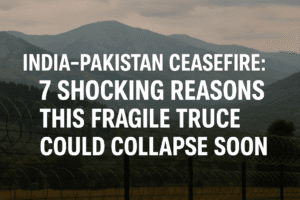India-Pakistan Ceasefire: 7 Shocking Reasons This Fragile Truce Could Collapse Soon
India and Pakistan’s fragile ceasefire, mediated by the U.S., offers temporary respite after days of intense cross-border clashes sparked by a militant attack in Kashmir. While hostilities have paused, competing claims of military victories—from strikes on alleged militant camps to downed aircraft—highlight entrenched mistrust and propaganda. For Kashmiris, shelling near the de facto border displaced thousands, though markets cautiously reopen amid lingering anxiety.
Historical tensions loom: the disputed region has seen ceasefires collapse repeatedly since 2003, with no resolution to its political status. Washington’s rare mediation underscores geopolitical stakes, yet lasting peace demands addressing Pakistan-based militancy and India’s hardline stance. Both nations, locked in posturing for domestic audiences, face pressure to de-escalate, but dialogue remains frozen since 2019. Without tackling Kashmir’s root issues, this truce risks becoming another fleeting calm before the next storm.

India-Pakistan Ceasefire: 7 Shocking Reasons This Fragile Truce Could Collapse Soon
As top military officials from India and Pakistan prepare to discuss the terms of a tenuous ceasefire, the Himalayan region of Kashmir holds its breath. The agreement, announced after four days of intense cross-border hostilities, marks a critical pause in a conflict that brought the nuclear-armed rivals perilously close to war. While the immediate violence has subsided, the path to lasting peace remains fraught with historical grievances, geopolitical posturing, and unanswered questions.
The Spark and Escalation
The recent flare-up traces back to a militant attack in Indian-administered Kashmir on April 22, which killed 26 security personnel. India blamed Jaish-e-Mohammed, a Pakistan-based group, prompting retaliatory airstrikes on alleged militant camps in Pakistan-administered Kashmir. Pakistan denied involvement but retaliated with its own strikes, leading to aerial dogfights, artillery exchanges, and competing claims of military triumphs.
Competing Narratives and Propaganda
Both nations have spun conflicting narratives:
- India claims it struck nine militant training camps, killing “over 100 terrorists,” and downplayed losses, stating, “all pilots are accounted for.”
- Pakistan asserts it targeted Indian military installations and shot down multiple aircraft, including advanced Rafale jets—a claim India dismisses.
Such discrepancies highlight the role of information warfare. Independent verification remains challenging, but analysts suggest inflated casualty figures and unverified victories are tactics to placate domestic audiences. As former diplomat Alyssa Ayres notes, “In such high-stakes conflicts, truth is often the first casualty.”
The U.S. Brokerage and Geopolitical Undertones
The U.S.’s role in mediating the ceasefire raises eyebrows. President Trump’s abrupt announcement, framed as a diplomatic win, underscores Washington’s vested interest in stabilizing South Asia amid its Afghan peace talks. However, experts caution that third-party mediation is rare for India and Pakistan, who historically prefer bilateral dialogue. The move may signal shifting U.S. priorities or an attempt to curb Chinese influence in the region, given Pakistan’s ties to Beijing.
Civilian Impact: A Respite for Kashmiris
For Kashmiris, the ceasefire offers temporary relief. During the clashes, villages near the Line of Control (LoC) endured heavy shelling, displacing thousands. Markets in Srinagar cautiously reopened, yet trauma lingers. “We’ve seen ceasefires collapse before,” says local journalist Anisa Khan. “Hope is fragile here.”
Historical Echoes and the Ceasefire’s Future
This isn’t the first ceasefire between India and Pakistan—and past agreements have often unraveled. Since 2003, violations along the LoC have surged, with 3,000+ incidents reported in 2020 alone. Skepticism abounds: “Ceasefires address symptoms, not the disease of Kashmir’s unresolved status,” argues security analyst Ajai Shukla.
The Road Ahead
Key challenges persist:
- Militant Groups: Pakistan’s alleged tolerance of anti-India militants remains a thorn.
- Domestic Politics: Both governments face pressure to appear strong. India’s upcoming elections and Pakistan’s economic crisis add complexity.
- Dialogue Stalemate: Diplomatic ties remain frozen since 2019, when India revoked Kashmir’s autonomy.
Monday’s military talks could set the tone for de-escalation, but trust is scarce. Confidence-building measures—like trade resumption or cultural exchanges—are unlikely without political will.
Conclusion: A Pause, Not Peace
The ceasefire is a diplomatic Band-Aid on a decades-old wound. While the immediate threat of war has receded, lasting peace demands addressing Kashmir’s political status, curbing militancy, and rebuilding bilateral channels. For now, the world watches as two adversaries navigate a fragile truce, aware that in Kashmir, calm is often just the prelude to another storm.
As the sun sets over Srinagar’s markets, the resilience of its people is overshadowed by a grim reality: without meaningful dialogue, the next trigger—a militant attack, a cross-border strike—could reignite a conflict with unimaginable consequences.
You must be logged in to post a comment.